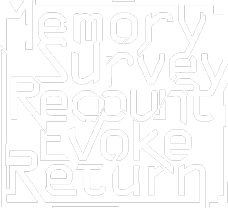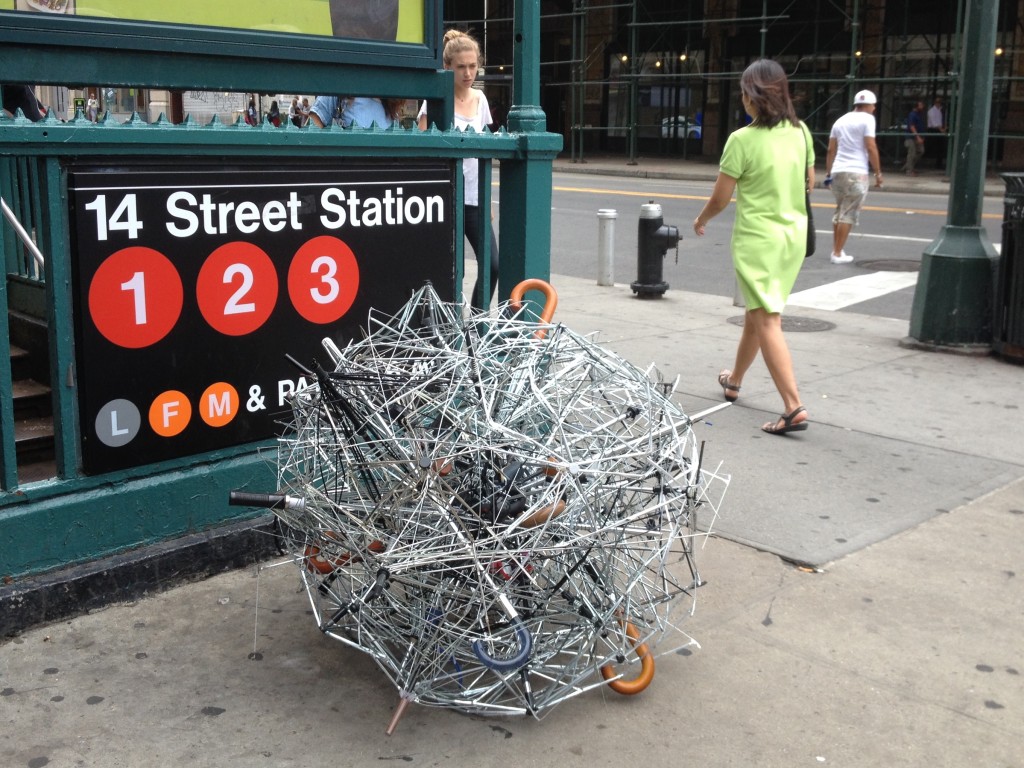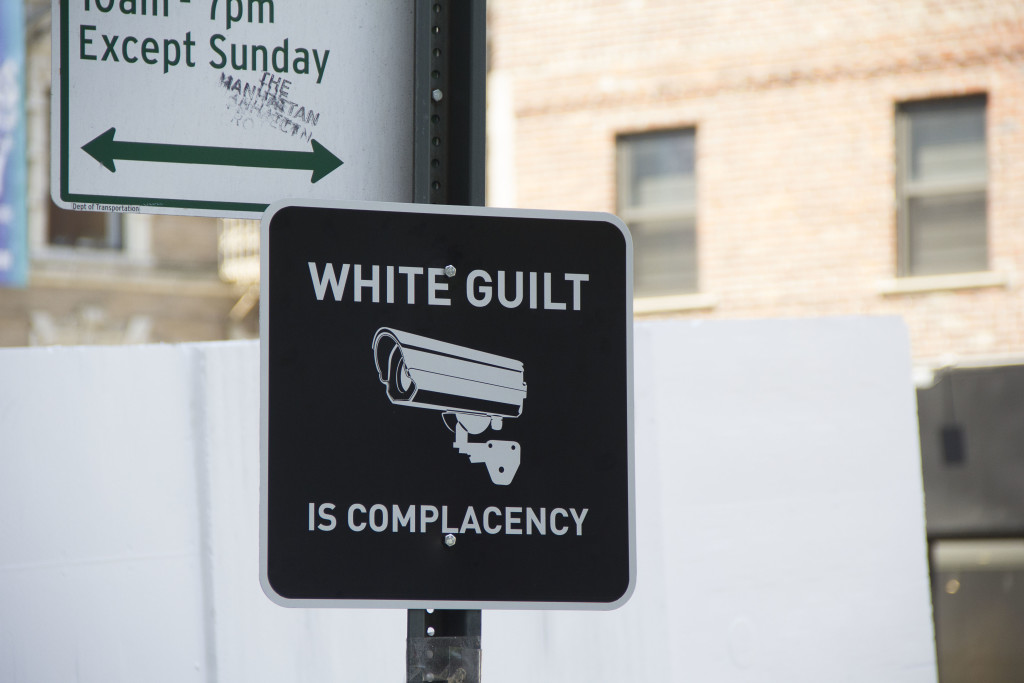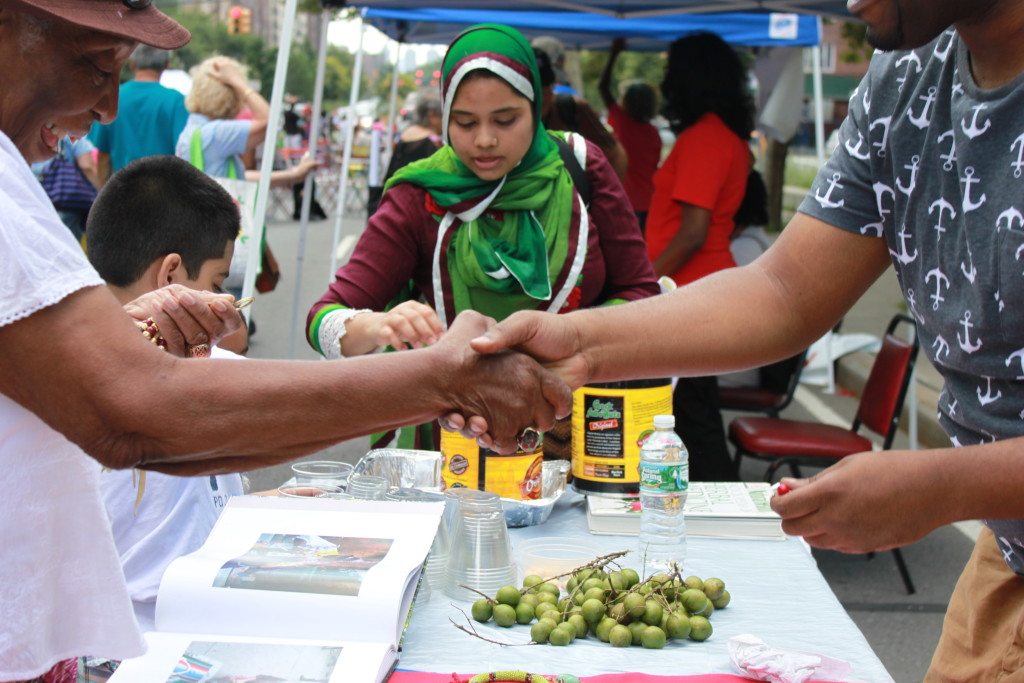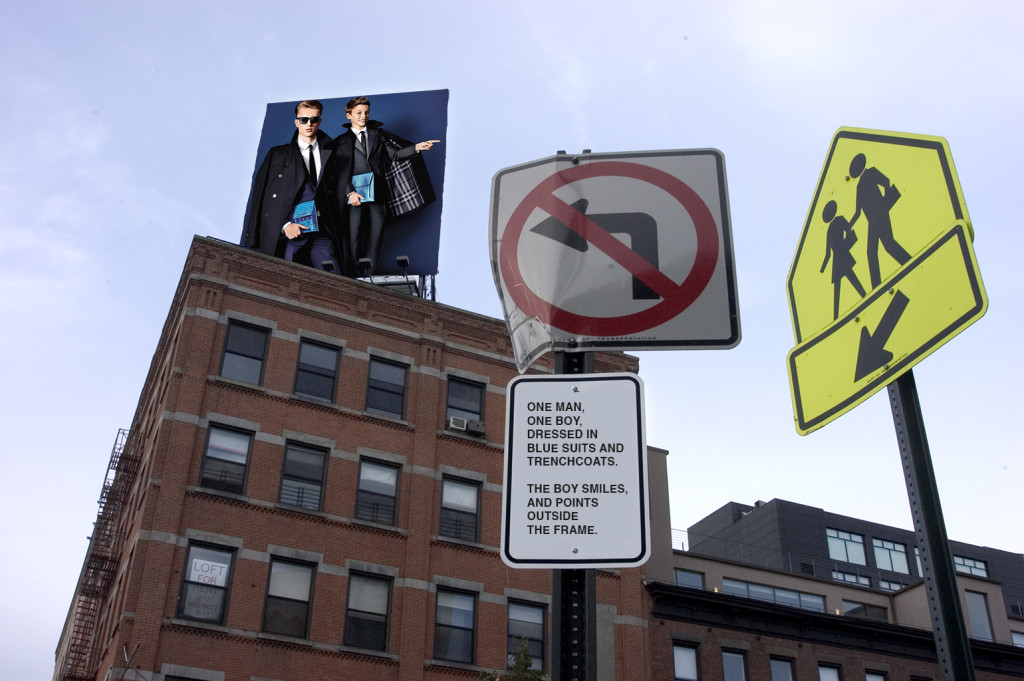Memory. Survey. Recount. Evoke. Return.
RECALL
October 7-11, 2015 on 14th Street, NYC
A festival exploring the odd, ordinary, and ingenious in the spectacle of daily life.
40+ ARTISTS TAKE ON 14th STREET TO SHOWCASE WORKS FROM THE PAST DECADE
For an 11th consecutive year, Art in Odd Places (AiOP) will stage provocative works of interactive art in unexpected public spaces along 14th Street in Manhattan. The 2015 edition of Art in Odd Places marks the festival’s odd numbered milestone anniversary–its 11th–with a survey of the first ten years of the festival. Events will begin on October 7 and conclude on October 11, with a festival reception to take place on October 9, from 5-8pm at Pedro Albizu Campos Plaza (14th Street between Avenues B and C).
The 2015 festival will recall 40 past artists as a survey of the 500+ total participating artists from the past 10 years of AiOP. Guest curators Kendal Henry and Sara Reisman consulted with past curators to establish an understanding of the festival’s history along 14th Street in Manhattan. “The artworks will be re-staged, in some cases on a fuller scale then the first time around, exploring through the artists’ installations, interventions, and performances how the slice of New York City that is 14th Street has been transformed” said Ms. Reisman. “The re-staged artists’ projects will be accompanied by a publicly accessible archive that will be designed to capture all of the past artists’ documentation, which has never before been collected in one place.”
The ethos of AiOP has always been one of sharing, openness, and accessibility. A boundary of many NYC neighborhoods, 14th Street was chosen as a location to host the festival as it transverses many diverse communities.
Committed to staging a transformative experience for a multi-generational audience, AiOP will feature the work of more than 40 artists, including:
The Umbrella Tumbleweed is a sculpture constructed from the remnants of the broken, discarded umbrellas which litter the city streets after every rain storm. Approximately 50 of these umbrella ‐ corpses have been interwoven to create a tumbleweed-like ball, about 3 feet in diameter.
COPY features aluminum street signs installed on existing New York City signposts at the intersection of 14th Street and 9th Avenue in Chelsea. Each sign is a textual copy of an ad appearing on a billboard mounted on a building opposite. COPY exposes the slippery, often counter-intuitive assumptions we make about the clarity or legibility of text and images, and shows how these images function in the context of our urban landscape.
Black Lives Matter Street Signs is a series of “official” street regulation signs that point to the difference between the law as stated and as implemented, and which ask people to consider the ways they may be complicit in the unequal application of laws according to race.
The thin, delicate materials of Draft are cast to form short dimensional texts suspended from scaffolding, unused sign poles, metal fencing, and other sites. The texts reference movement, fragility, and wind. Materials range from black Tyvek to green seaweed.
Good Trade questions capitalistic value systems by inviting passersby to place items they deem to be of value on a trade blanket, in exchange for another item of interest. By recreating this Native American custom in an urban environment, the artist reminds us that despite our capitalistic society filled with technology, simpler practices and ways of living still function. The mutual exchange between participants facilitates a forgotten form of communication.
AiOP is collaborative, horizontal, and constantly in-motion. Pushing the boundaries and limitations of public space, participating artists are chosen on a basis of artistic excellence, their work’s ability to create interaction with the community, and a successful record of collaborations.
WHO:
ARTISTS:
Nobutaka Aozaki | BAMTeam | Daniel Bejar | Isidro Blasco | Michael Paul Britto | David Antonio Cruz | Dennis Redmoon Darkeem | Carrie Dashow | Jordan Eagles | eteam | Nicholas Fraser | John Craig Freeman | Ghana ThinkTank | Monika Goetz | Lawrence Graham-Brown | Alicia Grullón | Terry Hardy | Leah Harper | Skowman Hastanan | Linda Hesh | The Illuminator | Yoko Inoue | Sam Jablon | Tomashi Jackson | Chad Laird | Pedro Lasch | Liz Linden | LuLu LoLo | LudiCity | L Mylott Manning | Carolina Mayorga | Irvin Climaco Morazan | Laura Napier | Olek | Jabari Owens-Bailey | Jenny Polak | Johannes Rantapuska & Milja Havas | Edith Raw | Jesse Seegers | Todd Shalom | Sasha Sumner & Nick Porcaro | Hank Willis Thomas | Tim Thyzel | Matej Valuka | Marieke Warmelink & Domenique Himmelschbach de Vries | Brooks Wenzel | Seldon Yuan
CO-CURATORS:
Sara Reisman is Artistic Director of the Shelley & Donald Rubin Foundation which supports arts and cultural activities that engage social justice. Reisman’s work at the foundation is focused on promoting access to arts and culture through grant making to organizations and programming The 8th Floor, an independent art space established by the Rubins in 2010, which hosts public events and exhibitions. In 2015 Reisman curated two exhibitions for The 8th Floor: Mobility and Its Discontents and Between History and the Body. From 2008 until 2014, Reisman was the director of New York City’s Percent for Art program which commissions permanent public artworks for newly constructed and renovated city-owned public spaces. During her tenure with the Percent for Art program, Reisman worked on more than 100 commissions, including projects with Pablo Helguera, Diego Medina, Julianne Swartz, Duke Riley, Ohad Meromi, and Karyn Olivier, among others for civic sites like libraries, public schools, correctional facilities, streetscapes and parks. Recent curatorial projects include “Still Acts”, a group exhibition at LaMaMa Galleria about the political potential of stillness in performance and choreography, co-curated with Ian Daniel (2014); and solo exhibitions with artists Christopher K. Ho, Leslie Johnson, and Claudia Joskowicz, at Forever & Today, Inc., where Reisman was guest curator during 2012 and 2013. She was the 2011 critic-in-residence at Art Omi, an international visual artist residency in upstate New York, and one of three 2013 Marica Vilcek Fellows, a research and travel fellowship organized by the Foundation for a Civil Society. In 2015 Reisman taught a contemporary art theory seminar, Art as Service at SUNY Purchase’s School of Art + Design and curated a related exhibition entitled I Serve Art, for the Richard and Dolly Maass Gallery at Purchase College.
Kendal Henry is an artist and curator who lives in New York City and specializes in the field of public art for over twenty-five years. He illustrates that public art can be used as a tool for social engagement, civic pride and economic development through the projects and programs he’s initiated in the US, Europe, Russia, Asia, Central Asia, Papua New Guinea, Australia and the Caribbean. Kendal believes that the most successful public artworks start with the question, “What is the artwork to achieve?” and takes into account the audience and surrounding environment in the creation of that artwork. He’s currently the Director of the NYC Department of Cultural Affairs Percent for Art Program and an adjunct professor at NYU’s Steinhardt School of Culture, Education and Human Development. He is a guest lecturer at various universities and educational institutions including the Abbey Mural Workshop at the National Academy Museum & School of Fine Arts; Rhode Island School of Design Senior Studio; and Pratt Institute’s Arts and Cultural Management Program. Kendal served as the Director of Culture and Economic Development for the City of Newburgh, NY where he created the region’s first Percent for Art Program. Prior to that post he was Manager of Arts Programs at the Metropolitan Transportation Authority (MTA) Arts for Transit for eleven years. During this time, he has overseen the commissioning, fabrication and installation of MTA’s permanent art projects, served as a member of the MTA’s in-house design team, and produced temporary exhibitions at Grand Central Terminal.Previous to this experience he served as a Project Manager at the New York City Department of Cultural Affairs’ Percent for Art Program. Kendal was also the Curator-at- large at the Museum of Contemporary African Diaspora Art (MoCADA) in Brooklyn, NY and was elected to serve two 3-year terms on the Americans for the Arts Public Art Network Council.
WHAT:
Art in Odd Places 2015: RECALL is the eleventh annual NYC festival featuring performances, interventions, visual installations, video, sound and more in public spaces. ALL EVENTS ARE FREE. For more information about AiOP’s history and artists’ project descriptions and schedules, visit the website: artinoddplaces.org.
WHEN:
The festival will take place from October 7-11, 2015, in various locations along 14th Street in Manhattan.
OPENING RECEPTION:
Friday, October 9, 5-8pm at Pedro Albizu Campos Plaza, 14th Street between Avenues B & C (southside).
Rain date: 7-10pm at Campos Community Center, 611 East 13th Street.
CRITICAL MASS:
Sunday, October 11, 2-4pm, 14th Street between Seventh and Ninth Avenues (southside)
PUBLIC PROGRAMS:
Saturday, October, 10
1-2:30pm: 14th Street business owners discuss their involvement with AiOP, the changing landscape of the street, and their thoughts on the role of art in public space.
Sunday, October 11
1 – 2:30pm: Seven RECALL artists set the agenda for an intense conversation on the most relevant topics to this years festival. Public participation for this event is welcome!
3:00pm: Join Co-curators Sara Reisman and Kendal Henry as they lead a performative walk starting in the west and heading east. The curators will stop to discuss and interact with performances and projects along the way.
All public program events take place at Jackson Square where Eighth Avenue, Greenwich Avenue, and W14th Street converge.
WHERE:
14th Street, Avenue C to the Hudson River, Manhattan, New York City Subways: 4, 5, 6, L, N, Q, R, W to Union Square; 1, 2, 3, A, C, E, F, V to 14th Street
L to First Avenue, Third Avenue, Union Square, Sixth Avenue, and Eighth Avenue
WHY:
Art in Odd Places (AiOP) is a thematic annual festival that presents visual and performance art in public spaces along 14th Street in Manhattan, NYC from Avenue C to the Hudson River each October. Active in New York City since 2005, AiOP aims to stretch the boundaries of communication in the public realm by presenting artworks in all disciplines outside the confines of traditional public space regulations. Using 14th Street as a laboratory, this project continues AiOP’s work to locate cracks in public space policies, and to inspire the popular imagination for new possibilities and engagement with civic space. Visit the website artinoddplaces.org AiOP is a project of GOH Productions.
CURATORIAL STATEMENT
The 2015 edition of Art in Odd Places, RECALL, celebrates the festival’s odd-numbered milestone anniversary – its 11th – with a survey of its first ten years. RECALL curators Sara Reisman and Kendal Henry consulted with the festival’s past curators to establish an understanding of Art in Odd Places’ history along 14th Street in Manhattan. Forty- seven past artists were invited—some deciding to reprise their past artworks while others opting to present new projects—as a snapshot of the more than 500 artists who have participated in the past ten years in New York City. In the process of bringing artists back to 14th Street, the artists’ installations, interventions, and performances reveal how the east to west swath of 14th Street has been transformed. That the festival is a cross-section of the city gives viewers a sense that while New York City often looks like a new, transformed city, in certain places it feels like little has changed, and the varied character of this two-mile stretch—in a continual state of flux—retains the qualities that have long defined New York City: its contradictions in wealth and culture from low to high and middling, and the awkward and beautiful intersections of planned public space with provisional architectures and improvisational interventions into the public realm.
The forty-seven odd artworks along 14th Street take into account a wide array of concerns that affect our lives in the city through artistic acts of generosity. Staged at the artists’ own risk, the artworks featured in Art in Odd Places take the form of public interventions, questioning the limits of how public space is used, regulated, and occupied. Mostly ephemeral in nature, the artists’ projects are preoccupied with the city’s subconscious, touching on issues of commercialism, gentrification, surveillance, economic disparities, accessibility of public space vis a vis disability, commemoration of both disappearing cultures and the lives of specific individuals. Not all news is bad news. Many projects celebrate the neighborhood’s past, and generate ideas about how we can actively engage in caring for the city’s environment and cultural ecology, how to participate in its future development, and how to appreciate the diversity of the culture that surrounds 14th Street and the many communities that converge here. Here we sit at the crossroads of Greenwich Village, Alphabet City, the East Village, Chelsea, the Flatiron District, Lower Midtown, and Gramercy Park, and the Meatpacking District.
Questioning what makes a place odd, Monika Goetz’s Coordinates functions like cross-hairs of a GPS system, honing in on an unremarkable location, marking it with a plaque listing its global position. Part of the oddness of 14th Street is the blurriness between art and commerce. Remember the first times you arrived in the city, or, if you were born here, the first time you recall crossing 14th Street. If you looked closely, you might have observed strange moments in which art and life blended together, especially in the context of the marketplace, both the infamous greenmarket of Union Square, and the intense commercial energy of the storefronts on the north and south sides of the street. Even today, in the midst of Union Square immense development, you still can encounter Hari Krishnas sitting together and singing, an artist who makes, arranges, and rearranges fake pigeons, and an artist who draws mandalas in chalk. Westward, the art market keeps accelerating, raising questions about what distinguishes art in a gallery from goods displayed in the window of a chain store. Hank Willis Thomas’ printed installation Black is Beautiful is a visual index of Jet magazine’s weekly pinup girls since 1953, blurring the boundary between the aesthetics of commercial print publications and those of visual art. Taking issue with advertising signage, Liz Linden’s reprinted advertisements along the street reflect on how readily we accept these constant intrusions into the public realm. Using disposable plastic bags, Nobutaka Aozaki brings back the portraits that he has drawn onto the ubiquitous smiley faces printed onto ephemeral yet everlasting bags that drift sideways and upwards into the trees, the city’s natural landscape.
Several artists in RECALL provide moments of pause to reflect on commemoration and its very nature. Tomashi Jackson’s three portraits of women who died in the face of encounters with the police are drawn onto storefront windows. LuLu LoLo’s Joan of Arc of 14th Street interrogates the lack of monuments that commemorate female historical figures. As Joan of Arc, she asks passersby where the monuments to women are, surveying them as to which women they think should be the subject of memorials in the city. Michael Paul Britto’s The Brown Man Experience: In Our Own Words seeks to give a positive voice to men of color as well as empower them to both confront and shift constructed racial perceptions.
Working with the neighborhood’s changing architecture, towards the east side, the band Jantar reprocesses sound from the film “Taxi Driver,” broadcasting it over a construction site at 520 East 14th Street, briefly capturing the historic sonic grit of the neighborhood. Isidro Blasco’s Not Really There is comprised of a series of architectural interventions that extend architectural details of the buildings along 14th Street, reflecting on the ever-changing and distorting nature of the city’s panorama.
Carrie Dashow and Skowmon Hastanan work within the Union Square Greenmarket to promote ideas about restoration and growth. Dashow, performing as Yesiree the Public Notary presents Mutual Life Assistance, conducting one-on-one Oaths of Growth with the public, urging them to take under their care – their own and the earth’s – as witnessed by the state of New York. Skowmon Hastanan’s Orchid Clinic provides free consultations on orchid care alongside greenmarket vendors.
Pedro Lasch’s War on 14th Street is a ten-year timeline that maps out important moments in global politics, designating one year per avenue. Lasch’s timeline will be drawn in chalk along the sidewalks, recalling a parallel historical record of the last decade, while Jordan Eagles’s Blood Illumination environments and projections reconsider a longer, more internalized struggle, making visible the health crisis associated with AIDS, linking diverse communities and generations of the neighborhood. Carolyn Mayorga’s Our Lady of Fourteenth Street will conjure the ghosts of the neighborhood’s past.
Touching on the senses, projects like Irvin Morazon’s performance with a seeing eye dog test how accommodating and accessible 14th Street and the city really are. LudiCity captures the relationship between sound and notions of community, privacy, and dialogue that comprise 14th Street’s past with six listening posts. Laura Napier will be stationed up above Union Square East as she choreographs This area will be photographed, acting as a human surveillance camera.
From this meta perspective, the mutuality of economic growth and urban planning become increasingly visible. The Illuminator’s Illuminating Student Debt reflects on the economic policies of academic institutions like those that now own much of the neighborhood’s real estate. Alicia Grullón’s The Disappearance of Other commemorates the resulting exclusionary energies that have emerged in this context. As if in response to these critical perspectives, Matej Vakula’s Manuals for Public Space simultaneously solicits public input and provides guidance for reclaiming public space on the local level.
Dennis Redmoon Darkeem and Yoko Inoue offer small-scale but concrete opportunities for economic exchange on a much more intimate level. Darkeem’s Good Trade reenacts Native American swap meet customs in the intensely commercialized district of Union Square, while Inoue will offer free subway rides using her unlimited Metrocard, swiping riders in every 18 minutes. Daniel Bejar’s Get Lost! project gives NYC’s Metropolitan Transit Authority’s subway maps a retro makeover, restoring the signs, maps, and names of places to what they may have geographically looked and sounded like prior to colonial intervention in 1609, recalling an early experience of what may have been, way back when.
Following the Art in Odd Places festival on 14th Street, The Lodge Gallery will host an exhibition, Art in Odd Places: RECALLed, from October 14- 28, organized by Caitlin Crews, Claire Demere, and Ikechukwu Casmir Onyewuenyi with Art in Odd Places curators Kendal Henry and Sara Reisman. The exhibition will feature a selection of artworks by artists participating in RECALL, and will be accompanied by a publicly accessible archive with current and past artists’ documentation. This archive will continue past the exhibition as an ongoing repository for Art in Odd Places’ history.
Press Contacts:
Laura Bandel, Public Relations Director • lebandel@gmail.com
Claire Demere, Curatorial Manager • claire.demere@gmail.com
For high resolution photos click HERE


